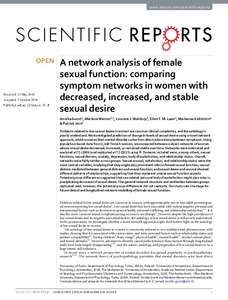A network analysis of female sexual function: comparing symptom networks in women with decreased, increased, and stable sexual desire
Annika Gunst; Marlene Werner; Lourens J. Waldorp; Ellen T. M. Laan; Marianne Källström; Patrick Jern
A network analysis of female sexual function: comparing symptom networks in women with decreased, increased, and stable sexual desire
Annika Gunst
Marlene Werner
Lourens J. Waldorp
Ellen T. M. Laan
Marianne Källström
Patrick Jern
NATURE PUBLISHING GROUP
Julkaisun pysyvä osoite on:
https://urn.fi/URN:NBN:fi-fe2021042720090
https://urn.fi/URN:NBN:fi-fe2021042720090
Tiivistelmä
Problems related to low sexual desire in women are common clinical complaints, and the aetiology is poorly understood. We investigated predictors of change in levels of sexual desire using a novel network approach, which assumes that mental disorders arise from direct interactions between symptoms. Using population-based data from 1,449 Finnish women, we compared between-subject networks of women whose sexual desire decreased, increased, or remained stable over time. Networks were estimated and analyzed at T1 (2006) and replicated at T2 (2013) using R. Domains included were, among others, sexual functions, sexual distress, anxiety, depression, body dissatisfaction, and relationship status. Overall, networks were fairly similar across groups. Sexual arousal, satisfaction, and relationship status were the most central variables, implying that they might play prominent roles in female sexual function; sexual distress mediated between general distress and sexual function; and sexual desire and arousal showed different patterns of relationships, suggesting that they represent unique sexual function aspects. Potential group-differences suggested that sex-related pain and body dissatisfaction might play roles in precipitating decreases of sexual desire. The general network structure and similarities between groups replicated well; however, the potential group-differences did not replicate. Our study sets the stage for future clinical and longitudinal network modelling of female sexual function.
Kokoelmat
- Rinnakkaistallenteet [27094]
